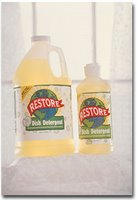 Mummifying our trash
Mummifying our trash
Landfills: protection by storageWhen we talk about helping the environment often times we speak about recycling instead of “landfilling” our trash or garbage. This July, Rebecca and I started composting our food waste. Composting is a way of recycling nutrients back to the earth.
One of the display items we showed during our Green Team presentations this summer was a food waste collection container loaned by Western Lake Superior Sanitary District (WLSSD) for special occasions like weddings, picnics and graduations. It really isn’t that special. It is just a large plastic garbage can lined with a biodegradable plastic bag. The container is returned to WLSSD and the food scraps are composted.
This project prompted an excellent question for Prof. Cricket from an Iowa woman. She asked, “Why don’t food and yard waste return to the earth in a landfill when they do in a compost pile?”
To understand why landfills don’t compost our waste, Prof. Cricket will give a mini-lesson in the construction of a landfill.
Landfills are actually like condominiums or tombs for our garbage. In the old days we had dumps. Anything and everything was thrown into a pile. Some places burned the garbage and others covered it up.
The problem was that there were no safeguards in place. Poisons could leach out of the dumps and into our water. Dumps were stinky places and often breeding grounds for disease-carrying insects and rodents. Today landfills are constructed. A lengthy process including an environmental impact study in which many experts such as geologists, biologists, social scientists and engineers scrutinize the effect of the landfill on the natural and social environment.
Landfills are lined with clay and plastic to prevent leachate or garbage-juice from leaking out. They are actually designed to slow down decomposition. A series of tubes and pipes are included underneath, through and around the landfill. These pipes collect the leachate to treat it so that it doesn’t containment water. Some of the leachate turns to methane gas and is vented through the pipes.
Each day the garbage at a landfill is covered with soil, which helps prevent odors and pests. This process is repeated until a section or cell is full. One landfill has many cells. When it is full it is capped off with clay and soil. It still needs to be monitored for future years.
Prof. Cricket wonders, “If a steak bone with meat on it is thrown in our kitchen garbage can, then to our alley trash can; picked up by our garbage truck and then transported and dumped into a sanitary landfill, which is later sealed and capped, will there still be meat on the bone 15 years later?”
An Anthropology professor at the University of Arizona, William L. Rathje, conducted several archeological excavations on landfills in Arizona, California and Illinois. This was named, “The Garbage Project.” He said of landfills, “They are vast mummifiers.” His team found readable newspapers, hot-dogs and a T-bone with meat and fat on it.
This archeological projected showed that a well-designed and managed landfill slows biodegration of some organic garbage to a standstill. Some never did start to biodegrade.
According to the EPA Americans throw away 25 percent of the food we prepare. This amounts to 96 million pounds of food waste. It costs us $1 billion.So while today’s landfill is a way to protect our water supply from dangerous pollutants and also prevent disease-carrying vermin. They aren’t a very good way to return organic materials to the earth.







